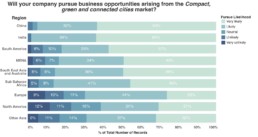Developing emerging cities in a compact, green and connected manner can reduce the capital cost of infrastructure investments and result in more attractive cities.
In developing countries, most of the people migrating from rural to urban areas move to small or medium-sized cities. These “emerging cities” are currently less burdened by overcrowding than many existing megacities. As they grow, far-sighted planning and investments will be needed to ensure that they are developed in a safe, productive and environmentally friendly fashion. This can result in more livable cities, but it can also dramatically reduce the capital costs of accommodating the influx of new arrivals. Indeed, focusing on developing emerging cities in a compact, green and connected manner could potentially reduce the capital costs of infrastructure investment by 6 percent (or 3 trillion USD globally) between now and 2030. This would simultaneously create impressive annual returns due to energy savings, higher productivity and reduced healthcare costs.

Crucial to this development is a focus on city planning that leads to more compact but also greener cities, in which many daily needs can be met within walking or biking distance and where long-range mobility is provided for by efficient, well-connected public transport. This would reduce air pollution, create more socially cohesive neighborhoods and drive faster growth due to energy and time savings.
Private investors can also benefit from promoting development with a focus on more compact, green, and connected cities. More housing units can be built if less room is needed for roads and parking, while parks and green areas in cities make them more attractive to buyers. Evidence of positive effects on property prices, biodiversity and reduced obesity due to physical activity has also been found. In addition, the benefits of achieving a healthier and better-connected city can also be expected to create employment in the long term, leading to a virtuous cycle in which more compact urban hubs concentrate innovation and job creation, in turn attracting more talent and capital. Public-private partnerships which facilitate collaboration between different stakeholder groups can be a valuable aspect of this approach.
Survey Findings
In India and China the respondents find the opportunity of building Compact, Green and Connected Cities to be very favorable for societies. This is especially interesting in light of the massive urbanization these countries are expected to see in the coming decades. North America, Europe and Other Asia rate this market opportunity less favorably.

There is a trend that the market opportunity is assessed positively in lower-middle-income economies, while respondents in high-income economies see it as less favorable. When assessed for its benefits to businesses and the capacity to inspire new business ventures this opportunity is rated highly. This is driven mainly by results from the manufacturing, governmental and other businesses sectors.

This market was surveyed globally in 2014 by more than 5500 leaders from both the public and private sectors. The survey was conducted in collaboration with the research company YouGov. The survey results were originally published in the Global Opportunity Report 2015.

